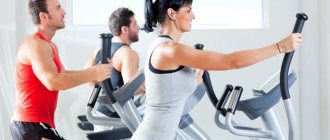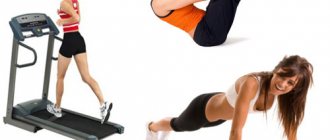Training
Warm-up
To avoid injury, you need to warm up. This way you will prepare your muscles for the subsequent load and provide the body with the necessary energy.
If you have an exercise bike at home, sit on it and pedal for at least five minutes. If not available, a ten-minute run in place is recommended. You need to work at a medium pace to work up a sweat. After this, take 7 minutes to stretch. Stretch not only your quadriceps, but also your lower back.
After warming up, move on to the main exercises.
Squats (can be done with dumbbells)
It is considered the most effective exercise, thanks to which the legs and other muscle groups are pumped. To achieve results, it is better to squat with dumbbells. However, without the correct technique, there is a risk of injury. If you follow the instructions below, you will minimize the risk of damage.
- Take dumbbells in your hands, arch your back, push your shoulders and chest forward. Feet stand shoulder width apart.
- Inhale and lower yourself to parallel. Toes and knees point in the same direction. Hover at the bottom for a couple of seconds.
- Exhale and return to the starting position. Do the required number of repetitions.
Lunges (can be done with dumbbells)
This exercise perfectly pumps the gluteal muscles. It is performed both with and without dumbbells. Let's consider the second option:
- stand straight, feet parallel to each other;
- bend at the waist;
- bend your knees slightly;
- step forward, your torso should remain straight;
- then repeat the same with the other leg.
Swing your feet forward
Considered an isolated exercise, it works the gluteus minimus and medius muscles. Swinging your legs is not difficult, it is only important to monitor your own sensations. Feel the tension in your buttocks. Otherwise, you should stop and understand what you are doing wrong.
- Get on all fours, place your knees on the floor, keep your back straight.
- Inhale and lift one leg back, holding this position for two seconds.
- Exhale and return to the starting position. Do the same with the other leg.
Scissors
Do the exercise like this:
- the initial position is exactly the same as in lunges;
- jump up and change the position of your legs in the air;
- the left leg becomes the supporting leg;
- Land as softly as possible.
Calf raise
It is considered the easiest exercise. Go to the wall and lift one leg up. Raise your other leg onto your toes.
For maximum effectiveness, stand on a slight elevation. Try to stretch your calves.
How to regulate training load?
By regularly training at home with your own weight, you can quickly reach your peak. To continue to progress, you need to increase the load. How can I do that?
- Train in circles. That is, increase the number of training laps per workout. A sequence of 10 exercises is one training circuit. The more times you perform them, the more intense the workout.
- Reduce your rest time. If you find it easy to do 3 rounds, then reduce the rest time between exercises.
- Increase your speed. Experiment with the speed of the exercise. For example, try squatting down slowly for 4 seconds and then explosively squatting up.
- Use weights. When the bodyweight load seems easy, use additional weights. Squats can be done with a kettlebell, and lunges with dumbbells in your hands.
***
New Fitseven materials, 5 times a week - in telegram:
- fit7seven
The presented leg workout is designed for beginner athletes. If you have experience in strength training, then we recommend doing basic exercises with free weights to pump up your legs, and do this workout as a recovery workout.
A set of exercises for the week
| Monday | ||
| Exercise | Approaches | Repetitions |
| Squats | 5 | 12-14 |
| Lunges | 4 | 10-12 |
| Calf raise | 4 | 20-25 |
| Wednesday | ||
| Exercise | Approaches | Repetitions |
| Swing your legs | 5 | 10-12 |
| Scissors | 4 | 10-15 |
| Calf raise | 3 | 15-20 |
| Friday | ||
| Exercise | Approaches | Repetitions |
| Lunges | 5 | 10-12 |
| Scissors | 5 | 10-15 |
| Calf raise | 2 | 20 |
Squats with dumbbells
Technique:
We recommend reading: Why do your arms hurt after training?
- Stand up straight. The distance of the legs should correspond to the width of the shoulders. Lower your arms with dumbbells along your body. Direct your gaze forward.
- Inhale, squat down so that the dumbbells remain level with your calves.
- Hold for a few seconds, and exhale, return to the starting position.
Number of repetitions:
3 sets of 20 reps.
Run
If you don’t want to do various exercises at home, you can run in the fresh air. Running works the leg muscles and improves the functioning of the cardiovascular system. When jogging over long distances, you won’t be able to create relief, so use simple sprinting. Using weights, you can reduce the amount of fat in your legs.
Instructions for proper jogging are as follows:
- run short distances on flat terrain so as not to “kill” your knee joints;
- choose a technique that is convenient, first of all, for yourself;
- buy shoes that will not cause discomfort;
- Don’t forget about stretching and warming up first.
Static squats
Technique:
- Stand up straight. Place your arms in front of you or grab dumbbells. Feet should be pointing forward. Keep your back straight.
- Squat down and stay in this position for 30 seconds. The bend angle at the knees should be about 90 degrees.
- Slowly return to the starting position.
Number of repetitions:
5 times.
Did you like the article? Subscribe to us on social networks and be the first to know about new products!
We recommend reading: Deadlift execution technique for men with a barbell
Nutrition
Scientists have not yet invented foods that will make you grow by leaps and bounds. But you can build muscle mass with regular nutrition. Just don’t think that there is some food that only makes your legs bigger.
So, here's what you should eat:
- quail and chicken eggs (an excellent source of protein);
- beef, veal and other lean meats;
- chicken breast and other sources of white meat;
- fish;
- milk and cottage cheese;
- legumes;
- brown and brown rice;
- buckwheat, oatmeal and pearl barley porridge;
- nuts;
- protein.
Lunges with dumbbells
Technique:
- Stand with dumbbells in your hands. Straighten your back.
- Inhale and lunge: bend one leg at the knee, take a step forward. The other limb remains in place, emphasis on the toe.
- Exhale and return to the starting position.
Number of repetitions:
3 sets of 12 reps for each leg.
We recommend reading: Nutrition for sushi - what can you eat? The best diets for drying out the body
Tips and tricks
There are many different types of exercises that can work specific leg muscles. When implementing them, you should follow the following simple rules:
- Don't stop practicing. Don't give up at the beginning and don't stop doing the exercises after achieving visible results. Exercise three to four days a week;
- Don’t get hung up on one or a few exercises: do complex exercises, include various types in your training;
- Make a training and exercise schedule (three days a week, each day has its own program, which should be changed once a month);
- Don't overwork yourself. Yes, sometimes it makes sense to perform approaches “to failure”, i.e. to the point where the muscle is no longer able to perform the exercise in a given set and requires rest. But this does not mean that your entire workout should consist of failure approaches.
- Be sure to warm up before training, this will develop your joints and prepare them for stress, which will allow you to exercise longer and reduce the chance of damage and injury;
- Don’t give up on your studies and remember the saying: patience and work will wear out everything.
We pump up the muscles of the thighs and buttocks
To work out these muscle groups, several complexes have been developed, divided according to the principle of sports training: for beginners who are little familiar with the sport, for those “initiated” in the sport and for those who can easily cope with the previous two “sets”.
The first training block “for beginners” consists of the following tasks for the body: “swimmer”, “bridge”, “metronome”, “chair”.
"Swimmer"
Starting position: lie on your stomach, arms extended in front of you. Raise all four limbs above the floor, spreading them apart. Inhale. Perform oscillatory movements with your arms and legs. “Swim” for about one minute. Exhalation. Lower your limbs, relax, restore your breathing rhythm. Repeat the exercise. Rest.
Keep the distance between your legs no more than 10 cm, from your feet to the floor - 16 cm, but at first 7-9 cm is acceptable. The time of each “swim” should increase from a minute gradually with each lesson, and after a while you can “swim” for as long as possible strength allows.
"Bridge"
Initial position: lying on your back, legs bent at the knees, spread slightly apart and resting on the floor. The arms are located along the body. Exhalation. Tighten your muscles, lift your butt up, leaning on your shoulder blades. Fix in the resulting position and smoothly lower down. In the first workouts, perform 3 sets of 13 repetitions. Later, you can do one set with the highest number of repetitions.
"Metronome"
Kneel with your hands on the floor, with your back and head parallel to the floor. Move the bent leg to the side to the level of your back. Move your leg in the opposite direction, turning your head in the same direction. Slowly lower your leg. Repeat 10 times. Repeat the task for the other leg. Increase the number of repetitions with each training session.
"High Chair"
Starting position – standing, feet shoulder-width apart. Perform a squat smoothly, as if there was a chair behind you. Fix in this position for as long as possible. To begin with, you can squat to a comfortable depth, performing three approaches. When it becomes possible to “sit on a chair” with your thighs parallel to the floor, you can switch to two approaches. The first is for 30 seconds, the second is for the maximum time.
You can move on to more complex exercises when it becomes possible to “sit on a chair” with ease, perform a “swimmer” for two minutes, do a “bridge” 50 times, and a “metronome” 20 times.
The second block includes squats, lunges with bends, and “horse”.
Squats
The initial position is standing, feet shoulder-width apart. Perform a squat so that the pelvic line drops below the knees, without lifting your heels off the floor. Perform two sets of 15-16 repetitions, the third set – as many times as possible. Squats like these, with your feet pressed to the floor, are effective and beneficial for the calf muscles.
Bent Lunges
Stand straight, arms down and holding dumbbells. The left leg steps forward, half-squatting with this leg. Bend forward, back straight, hands down to the floor. Return to starting position. Repeat for the right leg. Perform three to four sets of 20 repetitions, with a three-minute break.
"Horse"
The starting position is on the elbows and knees, one leg is raised 10 cm. Raise this leg even higher, pause and lower it to the starting position (not to the floor, but 10 cm from it). Perform as many lifts as possible in three sets for each lower limb, with a two-minute break.
To complete the training, you can do the “chair” exercise from the previous block.
The third sports block includes: lunges, side lunges with a jump, “one-sided bridge”, push-ups with one leg.
To begin with, you can perform classic squats (as in the previous block).
Lunges
Start: stand straight, hands on your belt. Step forward with one leg, bend this leg, its thigh should be parallel to the floor. Without pausing, return to the starting position. Repeat for the second lower limb. Perform 10 lunges for each leg.
Side lunges with jump
The starting position is the same as for a normal lunge. Squat with your right leg, straighten your left leg to the side. Jump into the starting stance. Bend your back forward, touch the floor with both hands (preferably with fists). Jump onto your left leg, with your right leg extended to the side. Perform as many times as possible.
"One Way Bridge"
Performed similarly to the “bridge”, with only one leg. Do three sets with the maximum possible number of “bridges” for each lower limb.
Single leg push-ups
Place your hands on a raised surface at waist level. Perform push-ups with one leg raised. Hold for 3 minutes (more is possible).
Each of the above complexes does not exclude the other. They can be alternated. The first can be performed daily, the second and third three times a week. When the above exercises begin to be performed without much effort, you can add weights to the arms or legs (or to all limbs).
Stretching exercises
The leg muscles need to be pumped with different amounts of effort. Their stretching is ensured by the following exercises:
- IP - sitting on the floor, one leg extended and the other bent at the knee. A towel is placed on the foot of the straight leg, with the help of which the leg is lifted up. The extreme position is delayed for 15-25 s. Then, everything is repeated with the second limb.
- IP - standing with straight arms resting on the wall, your back should be straight. By bending your arms, your body moves closer to the wall, while keeping your feet stationary. You should feel the tension in your calf muscles. In the extreme position you need to stop for 20-25 seconds.
- IP – standing on tiptoes, legs spread shoulder-width apart. Do squats as deep as possible without dropping your heels. In order to quickly strengthen muscles, it is better to do squats while holding dumbbells or other weights in your hands (its weight increases gradually).
- IP - squatting. Straightening is done slowly, while the legs are shoulder-width apart, and the arms are kept lowered along the body (preferably with weights). Number of repetitions – 12-16 times.
All exercises cannot load only one muscle. Often, when stretching the calf muscles, the muscles of the thighs and buttocks are also involved. This circumstance must be taken into account when developing a general training program.
Leg training tips
It is quite problematic for a man to pump up his legs at home.
The leg muscles are the largest and strongest part of the human body. Therefore, solid weights and various exercises are traditionally used in the training process.
You can progress at home for some time, but after a couple of months the arsenal of possible movements will dry up and the results will no longer be pleasing.
Leg training in the gym is more suitable for men.
Usually a separate lesson is devoted to it, in which several exercises are performed for the front and back of the thigh, and one or two for the calf muscles.
Opinions are divided on the optimal leg rep range.
When exercising to increase muscle volume in the thighs, there are 2 options:
- Leg training is carried out in a high-repetition mode, in the range of 15-20 times per approach
- Low rep – 6-10 reps per set
Modern bodybuilders have long ceased to argue which method is more effective. Practice has shown that for maximum results it is best to alternate these two schemes.











